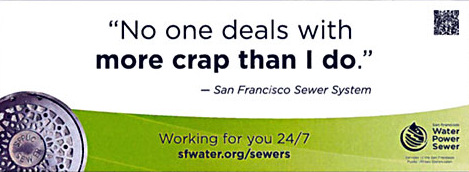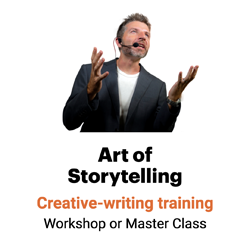3 ways to incorporate humor into your writing
Humor is one of the Top 3 reasons people share information, according to a study by Chadwick Martin Bailey:

- Because I find it interesting/entertaining (72%)
- To get a laugh (58%)
- Because I think it will be helpful to recipients (58%)
So how can content writers and others add humor to your content marketing, blog posts and other communication campaigns? You don’t need a class in comedy writing to write funnier. You don’t even need to be a funny person, though a sense of humor may help you find funny material.
Here are three ways to get your target audience to click, read, like and share your message by adding humor to your content:
1. Try self-deprecating humor.
When executives at the San Francisco sewer department needed to call attention to the system’s crumbling infrastructure, PR pros at Davis & Associates knew just what was needed.
Poop jokes.

Traditionally, outreach for public agencies has been formulaic, sober and dull. But blah-blahing about upgrading failing infrastructure to ensure the reliability and performance now and into the future wasn’t going to cut it.
So D&A PR professionals stole a line from critics of the deteriorating sewer system, who sized up the situation, tongue in cheek, as “a bunch of crap.”

D&A pros pushed their client to “walk the fine line between attention getting and off-putting” (PDF, PRSA members only).
They plastered “No one deals with more crap than I do” and “You can’t live a day without me” ads on buses and Facebook feeds. They offered fun facts on their campaign website, hosted a quiz with prizes and even wrote a rap song. Because of course they did.

The results? Coverage by Inc. and Fast Company. In-depth stories on the local news. A double-digit increase in social media engagement.
And — oh, yes — a PRSA Silver Anvil for Davis & Associates PR pros.
Which means, of course, that they are hot, um, stuff.
Are you taking yourself, your organization and your offerings too seriously?
2. Tell a joke.
When I first joined the National Speakers Association, jokes had a terrible name:
Jokes are old-fashioned, simple and lame.
They sound like they came from a joke book.
You run the risk that your audience has heard them before, making you appear to be stealing old humor.
Only original observational humor, in the form of personal stories, will do.
But seriously, folks, jokes — even old jokes — can help you make a point.
So how can you use jokes without looking lame?
Hook and hinge, suggests Sam Horn, author of POP! Stand Out In Any Crowd. “The joke hooks people’s interest, and then you hinge the punch line onto how it’s relevant to your point,” she writes.
Here’s how it works, in a speech by former Sprint CEO William T. Esrey at a telecom conference:
1. Expected direction:
2. Unexpected turn/hook:
3. Hinge to the point:
4. State your point:
Because you’re using the joke to make a point and not just to entertain, readers and other audience members will forgive you for being more amusing than hilarious.
And if the joke has been around for awhile? Introduce it as an old joke. Then your readers will know you know. And you’ll all be in on the joke.
3. Twist a list.
A New Yorker cartoon shows pirates making three sailors walk the plank. “You’re right,” one of the pirates says. “Things are funnier in threes.”
Stuck for humor? Try a series of three or more items. Series allow you to surprise and amuse your reader by breaking the pattern.
1. Twist a list. One way to use a series for humor is to twist a list. That is:
- Set your list up with two or more serious items.
- Break the pattern with a funny final item — aka your punchline.
Stephen Colbert used this approach on a recent episode of “The Colbert Report” when he compared:
- Christianity
- Islam
- Hinduism
- Buddhism
- The Toyota Camry
What funny thing could you add to a list of serious items to twist a list in your next piece?
2. Make a list. In “Three Things,” his copyediting e-zine for Entergy employees, Chris Smith always starts with a triad quote. One of my favorites:
“Irish coffee contains the three major food groups: alcohol, caffeine and sugar.”
— Michael Eck, on The Book of Threes website
Then Smith takes off from that triad to build a list of three tips:
- Alcohol notwithstanding, don’t be negative, be appositive. …
- If, like nearly everyone, you often must revise or edit with sufficient caffeine but insufficient time, consider these fast-editing gems from Carl Sessions Stepp …
- Sugar and spice and filenames are nice. …
3. Count off a list. In a restaurant, I once overheard a diner say:
“The six most beautiful words in the English language: ‘I’ll have the rack of lamb.’”
Yesterday I tweeted:
The five words you never want to hear your new yoga teacher say: ‘Plank is my favorite pose.”
What are the nicest (or worst) words in your organization?
Tax season is over?
Budgets are due Monday?
Use “the X most X words in the English language” setup to add a little humor to your next piece.
4. Extend a list. You can also find humor in a series by extending someone else’s list. In Eat the Rich, P.J. O’Rourke extended a quote by Winston Churchill:
“Russia is a riddle wrapped in a mystery, inside an enigma, tied in a hankie, rolled in a blanket and packed in a box full of little Styrofoam peanuts,” said Winston Churchill, or something like that.
Got a series? Just keep adding items … in escalating order of ridiculousness.

Leave a Reply